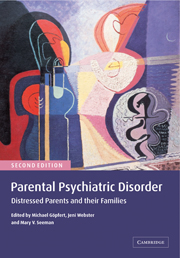Book contents
- Frontmatter
- Contents
- List of contributors
- Foreword
- Preface
- Part I Basic issues
- Part II Comprehensive assessment and treatment
- Part III Specific disorders: the impact on parent–child relationships
- Part IV Specific treatments and service needs
- 16 Psychopharmacology and motherhood
- 17 Social work issues
- 18 Parental psychiatric disorder and the law: the American case
- 19 Parenting and mental illness. Legal frameworks and issues – some international comparisons
- Part V Child-sensitive therapeutic interventions
- Part VI Models for collaborative services and staff training
- Afterword
- Index
- References
16 - Psychopharmacology and motherhood
from Part IV - Specific treatments and service needs
Published online by Cambridge University Press: 09 August 2009
- Frontmatter
- Contents
- List of contributors
- Foreword
- Preface
- Part I Basic issues
- Part II Comprehensive assessment and treatment
- Part III Specific disorders: the impact on parent–child relationships
- Part IV Specific treatments and service needs
- 16 Psychopharmacology and motherhood
- 17 Social work issues
- 18 Parental psychiatric disorder and the law: the American case
- 19 Parenting and mental illness. Legal frameworks and issues – some international comparisons
- Part V Child-sensitive therapeutic interventions
- Part VI Models for collaborative services and staff training
- Afterword
- Index
- References
Summary
One of the most difficult decisions for women suffering from a chronic or recurrent illness is whether or not to continue taking maintenance medications during pregnancy. Women know that they should not smoke, drink alcohol or take street drugs when they are pregnant. But they are unsure about prescribed medication. The dilemma is particularly difficult for women who are unclear about their need for medication. This predicament is well captured in a Canadian study of focus group discussions among women diagnosed with schizophrenia (Chisholm, 1999). In this group of women, pregnancies were reported as largely unplanned. The question they faced at the time of the pregnancy was whether to stop antipsychotic medication or, by continuing, to harm (perhaps) their developing child. These women related mixed experience with respect to the help they received from their doctors. Some found their doctors' advice helpful; others not. More than one woman in the focus groups expressed serious regret at having opted for abortion because of the impossibility of resolving this issue. The dilemma is expressed succinctly by one of the women:
One of the biggest things I had to contend with when I thought I wanted to have a baby is you can't go off your medication just like that and this medication is potentially very, extremely damaging to a fetus.
The ideal pregnancy is one that is preplanned, with the mother-to-be taking prenatal vitamins containing folic acid a full 6 weeks prior to conception.
- Type
- Chapter
- Information
- Parental Psychiatric DisorderDistressed Parents and their Families, pp. 241 - 248Publisher: Cambridge University PressPrint publication year: 2004



